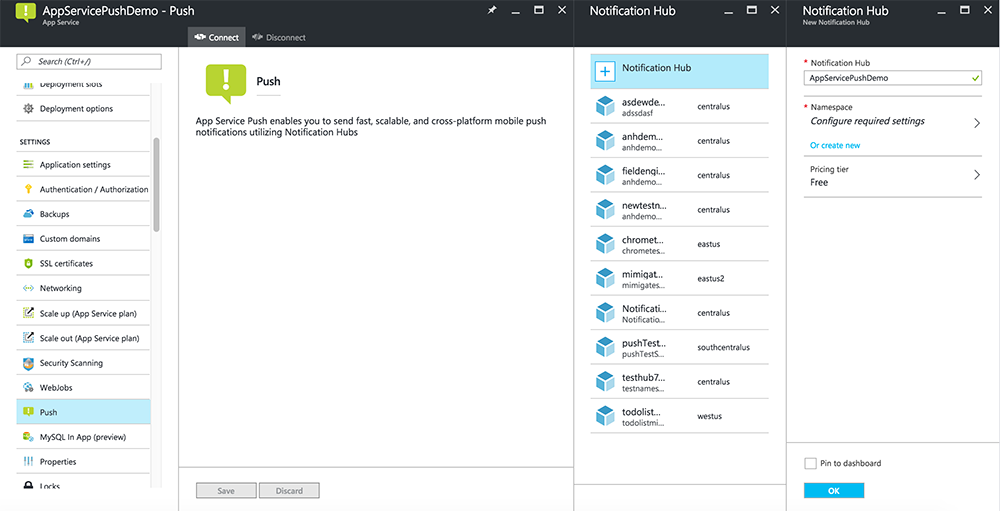iOS アプリへのプッシュ通知の追加
概要
このチュートリアルでは、iOS クイックスタート プロジェクトにプッシュ通知を追加して、レコードが挿入されるたびにプッシュ通知が送信されるようにします。
ダウンロードしたクイックスタートのサーバー プロジェクトを使用しない場合は、プッシュ通知拡張機能パッケージを追加する必要があります。 詳細については、「Azure Mobile Apps 用 .NET バックエンド サーバー SDK の操作」を参照してください。
iOS シミュレーターでは、プッシュ通知はサポートされていません。 物理 iOS デバイスと Apple Developer Program メンバーシップが必要です。
通知ハブを構成する
Azure App Service の Mobile Apps 機能は Azure Notification Hubs を使用してプッシュを送信するため、ここではモバイル アプリの通知ハブを構成します。
Azure Portal で、[App Services] に移動し、アプリ バックエンドを選択します。 [設定] で [プッシュ] を選択します。
通知ハブ リソースをアプリに追加するには、[接続] を選択します。 ハブを作成することも、既存のハブに接続することもできます。

これで、通知ハブが Mobile Apps のバックエンド プロジェクトに接続されました。 後でこの通知ハブを構成して、デバイスにプッシュ通知を送信するプラットフォーム通知システム (PNS) に接続します。
アプリをプッシュ通知用に登録する
- アプリのアプリ ID を登録します。 明示的なアプリ ID (ワイルドカード アプリ ID ではなく) を作成し、 バンドル ID の場合は、Xcode クイックスタート プロジェクトにある正確なバンドル ID を使用します。 [Push Notifications (プッシュ通知)] チェック ボックスをオンにすることも重要です。
- 次に、プッシュ通知を構成するための準備として、"開発" または "配布" SSL 証明書を作成します。
プッシュ通知を送信するように Azure を構成する
- お使いの Mac で、 Keychain Accessを起動します。 左側のナビゲーション バーで、[分類] の [自分の証明書] を開きます。 前のセクションでダウンロードした SSL 証明書を見つけ、その内容を開示します。 (秘密キーを選択せずに) 証明書のみを選択します。 次に、それをエクスポートします。
- Azure Portal で [すべて参照]>[App Services] の順に選択します。 次に、Mobile Apps バックエンドを選択します。
- [設定] で [App Service Push]\(App Service プッシュ\) を選択します。 次に、通知ハブの名前を選択します。
- Apple プッシュ通知サービス>のアップロード証明書に移動します。 .p12 ファイルをアップロードし、正しい モード を選択します (以前のクライアント SSL 証明書が運用環境かサンドボックスかによって異なります)。 すべての変更を保存します。
これで、iOS のプッシュ通知と連携するようにサービスが構成されました。
プッシュ通知を送信するようにバックエンドを更新する
.NET バックエンド (C#):
Visual Studio でサーバー プロジェクトを右クリックし、[NuGet パッケージの管理] をクリックして
Microsoft.Azure.NotificationHubsを見つけ、[インストール] をクリックします。 これにより、バックエンドから通知を送信するために必要な Notification Hubs ライブラリがインストールされます。バックエンドの Visual Studio プロジェクトで、 Controllers>TodoItemController.cs を開きます。 ファイルの先頭に、次の
usingステートメントを追加します。using Microsoft.Azure.Mobile.Server.Config; using Microsoft.Azure.NotificationHubs;PostTodoItemメソッドを次のコードに置き換えます。public async Task<IHttpActionResult> PostTodoItem(TodoItem item) { TodoItem current = await InsertAsync(item); // Get the settings for the server project. HttpConfiguration config = this.Configuration; MobileAppSettingsDictionary settings = this.Configuration.GetMobileAppSettingsProvider().GetMobileAppSettings(); // Get the Notification Hubs credentials for the Mobile App. string notificationHubName = settings.NotificationHubName; string notificationHubConnection = settings .Connections[MobileAppSettingsKeys.NotificationHubConnectionString].ConnectionString; // Create a new Notification Hub client. NotificationHubClient hub = NotificationHubClient .CreateClientFromConnectionString(notificationHubConnection, notificationHubName); // iOS payload var appleNotificationPayload = "{\"aps\":{\"alert\":\"" + item.Text + "\"}}"; try { // Send the push notification and log the results. var result = await hub.SendAppleNativeNotificationAsync(appleNotificationPayload); // Write the success result to the logs. config.Services.GetTraceWriter().Info(result.State.ToString()); } catch (System.Exception ex) { // Write the failure result to the logs. config.Services.GetTraceWriter() .Error(ex.Message, null, "Push.SendAsync Error"); } return CreatedAtRoute("Tables", new { id = current.Id }, current); }サーバー プロジェクトを発行します。
Node.js バックエンド:
バックエンド プロジェクトを設定します。
todoitem.js テーブル スクリプトを次のコードで置き換えます。
var azureMobileApps = require('azure-mobile-apps'), promises = require('azure-mobile-apps/src/utilities/promises'), logger = require('azure-mobile-apps/src/logger'); var table = azureMobileApps.table(); // When adding record, send a push notification via APNS table.insert(function (context) { // For details of the Notification Hubs JavaScript SDK, // see https://aka.ms/nodejshubs logger.info('Running TodoItem.insert'); // Create a payload that contains the new item Text. var payload = "{\"aps\":{\"alert\":\"" + context.item.text + "\"}}"; // Execute the insert; Push as a post-execute action when results are returned as a Promise. return context.execute() .then(function (results) { // Only do the push if configured if (context.push) { context.push.apns.send(null, payload, function (error) { if (error) { logger.error('Error while sending push notification: ', error); } else { logger.info('Push notification sent successfully!'); } }); } return results; }) .catch(function (error) { logger.error('Error while running context.execute: ', error); }); }); module.exports = table;ローカル コンピューターでファイルを編集するときは、サーバー プロジェクトを再発行します。
プッシュ通知をアプリに追加する
Objective-C:
QSAppDelegate.m で、iOS SDK と QSTodoService.h をインポートします。
#import <MicrosoftAzureMobile/MicrosoftAzureMobile.h> #import "QSTodoService.h"QSAppDelegate.m で
didFinishLaunchingWithOptions、次の行を直前にreturn YES;挿入します。UIUserNotificationSettings* notificationSettings = [UIUserNotificationSettings settingsForTypes:UIUserNotificationTypeAlert | UIUserNotificationTypeBadge | UIUserNotificationTypeSound categories:nil]; [[UIApplication sharedApplication] registerUserNotificationSettings:notificationSettings]; [[UIApplication sharedApplication] registerForRemoteNotifications];QSAppDelegate.m で、次のハンドラー メソッドを追加します。 これで、アプリケーションがプッシュ通知をサポートするように更新されました。
// Registration with APNs is successful - (void)application:(UIApplication *)application didRegisterForRemoteNotificationsWithDeviceToken:(NSData *)deviceToken { QSTodoService *todoService = [QSTodoService defaultService]; MSClient *client = todoService.client; [client.push registerDeviceToken:deviceToken completion:^(NSError *error) { if (error != nil) { NSLog(@"Error registering for notifications: %@", error); } }]; } // Handle any failure to register - (void)application:(UIApplication *)application didFailToRegisterForRemoteNotificationsWithError: (NSError *)error { NSLog(@"Failed to register for remote notifications: %@", error); } // Use userInfo in the payload to display an alert. - (void)application:(UIApplication *)application didReceiveRemoteNotification:(NSDictionary *)userInfo { NSLog(@"%@", userInfo); NSDictionary *apsPayload = userInfo[@"aps"]; NSString *alertString = apsPayload[@"alert"]; // Create alert with notification content. UIAlertController *alertController = [UIAlertController alertControllerWithTitle:@"Notification" message:alertString preferredStyle:UIAlertControllerStyleAlert]; UIAlertAction *cancelAction = [UIAlertAction actionWithTitle:NSLocalizedString(@"Cancel", @"Cancel") style:UIAlertActionStyleCancel handler:^(UIAlertAction *action) { NSLog(@"Cancel"); }]; UIAlertAction *okAction = [UIAlertAction actionWithTitle:NSLocalizedString(@"OK", @"OK") style:UIAlertActionStyleDefault handler:^(UIAlertAction *action) { NSLog(@"OK"); }]; [alertController addAction:cancelAction]; [alertController addAction:okAction]; // Get current view controller. UIViewController *currentViewController = [[[[UIApplication sharedApplication] delegate] window] rootViewController]; while (currentViewController.presentedViewController) { currentViewController = currentViewController.presentedViewController; } // Display alert. [currentViewController presentViewController:alertController animated:YES completion:nil]; }
Swift:
次の内容を含む ClientManager.swift ファイルを追加します。 %AppUrl% を Azure モバイル アプリ バックエンドの URL に置き換えます。
class ClientManager { static let sharedClient = MSClient(applicationURLString: "%AppUrl%") }ToDoTableViewController.swift で、
MSClientを初期化するlet client行を次の行に置き換えます。let client = ClientManager.sharedClientAppDelegate.swift で、
func applicationの本文を次のように置き換えます。func application(application: UIApplication, didFinishLaunchingWithOptions launchOptions: [NSObject: AnyObject]?) -> Bool { application.registerUserNotificationSettings( UIUserNotificationSettings(forTypes: [.Alert, .Badge, .Sound], categories: nil)) application.registerForRemoteNotifications() return true }AppDelegate.swiftで、次のハンドラー メソッドを追加します。 これで、アプリケーションがプッシュ通知をサポートするように更新されました。
func application(application: UIApplication, didRegisterForRemoteNotificationsWithDeviceToken deviceToken: NSData) { ClientManager.sharedClient.push?.registerDeviceToken(deviceToken) { error in print("Error registering for notifications: ", error?.description) } } func application(application: UIApplication, didFailToRegisterForRemoteNotificationsWithError error: NSError) { print("Failed to register for remote notifications: ", error.description) } func application(application: UIApplication, didReceiveRemoteNotification userInfo: [NSObject: AnyObject]) { print(userInfo) let apsNotification = userInfo["aps"] as? NSDictionary let apsString = apsNotification?["alert"] as? String let alert = UIAlertController(title: "Alert", message: apsString, preferredStyle: .Alert) let okAction = UIAlertAction(title: "OK", style: .Default) { _ in print("OK") } let cancelAction = UIAlertAction(title: "Cancel", style: .Default) { _ in print("Cancel") } alert.addAction(okAction) alert.addAction(cancelAction) var currentViewController = self.window?.rootViewController while currentViewController?.presentedViewController != nil { currentViewController = currentViewController?.presentedViewController } currentViewController?.presentViewController(alert, animated: true) {} }
プッシュ通知をテストする
- Xcode で [Run] をクリックし、iOS デバイスでアプリを起動します (シミュレーターではプッシュは機能しません)。 [OK] をクリックしてプッシュ通知を受け入れます。この要求は、アプリの初回実行時に発生します。
- アプリで新しい項目を追加し、 +をクリックします。
- 通知が受信されたことを確認し、[ OK] を クリックして通知を閉じます。 これで、このチュートリアルは終了です。
詳細
- テンプレートを利用すれば、プラットフォーム間のプッシュやローカライズされたプッシュを柔軟に送信できます。 Azure Mobile Services 向け iOS クライアント ライブラリの使用方法 」に記載されています。